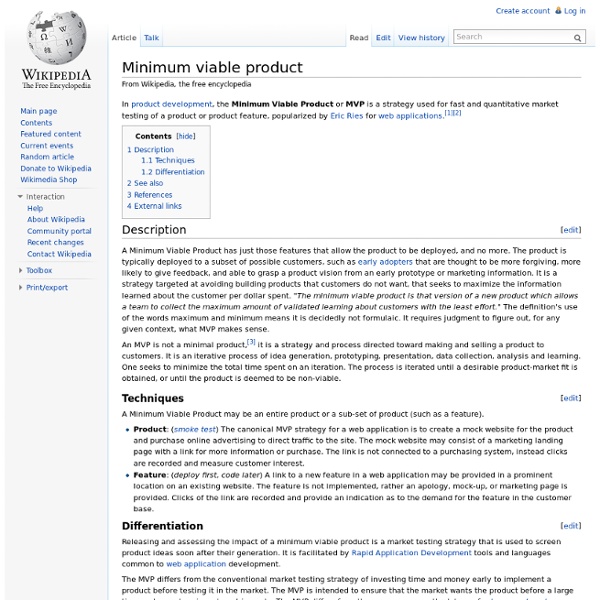Minimum viable product
In product development, the minimum viable product (MVP) is a strategy used for fast and quantitative market testing of a product or product feature. The term was coined by Frank Robinson and popularized by Eric Ries for web applications.[1][2] It may also involve carrying out market analysis beforehand. Description[edit] A minimum viable product has just those core features that allow the product to be deployed, and no more. An MVP is not a minimal product,[3] it is a strategy and process directed toward making and selling a product to customers. Techniques[edit] A minimum viable product may be a prototype, an entire product, or a sub-set of product (such as a feature). Differentiation[edit] Releasing and assessing the impact of a minimum viable product is a market testing strategy that is used to screen product ideas soon after their generation. See also[edit] References[edit] External links[edit]
POP - Prototyping on Paper | iPhone App Prototyping Made Easy
22 gute Adressen, um Erklärvideos produzieren zu lassen
Wozu Unternehmen Erklärvideos einsetzen können, welchen Nutzen sie dadurch haben, mit welchen Techniken und in welchen Stilen die Videos realisiert werden, haben wir im Artikel “Mit Erklärvideos komplexe Zusammenhänge verständlich und unterhaltsam vermitteln” beschrieben. Um die Recherche nach dem passenden Dienstleister zu erleichtern, sind hier 22 Produktionsfirmen von Erklärvideos in alphabetischer Reihenfolge zu finden. Action-selection.de Action selection aus Berlin produzieren Erklärvideos mittels animierter Grafiken AHA! Erklärvideos mit animierten Zeichnungen und Fotos im Collagestil aus Weil am Rhein AniManual Animierte Grafiken und Fotos in kreativem Collagestil mit 9 Stilen zur Auswahl aus Frankfurt Bishop-Productions.de Neben Erklärvideos produziert Bishop-Productions aus Hamburg auch viele andere Videoarten. Dewon.de Seinen Sitz in Wolfenbüttel hat Dewon.de. dot-gruppe.com In Berlin produziert die dot-gruppe unterhaltsame Erklärvideos mit 2D-Animationen. emniconCampus.de Explain.it
Related:
Related:



